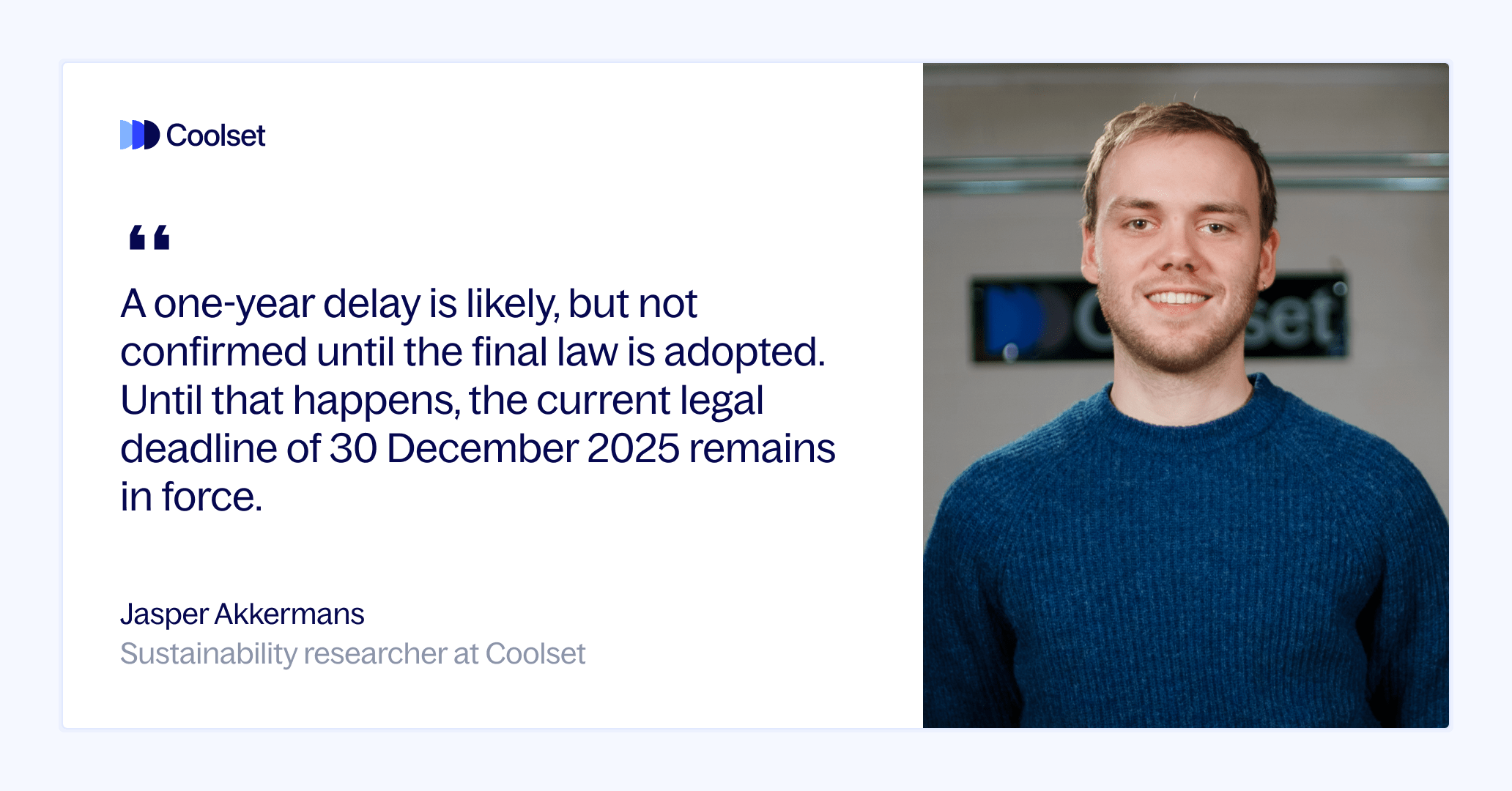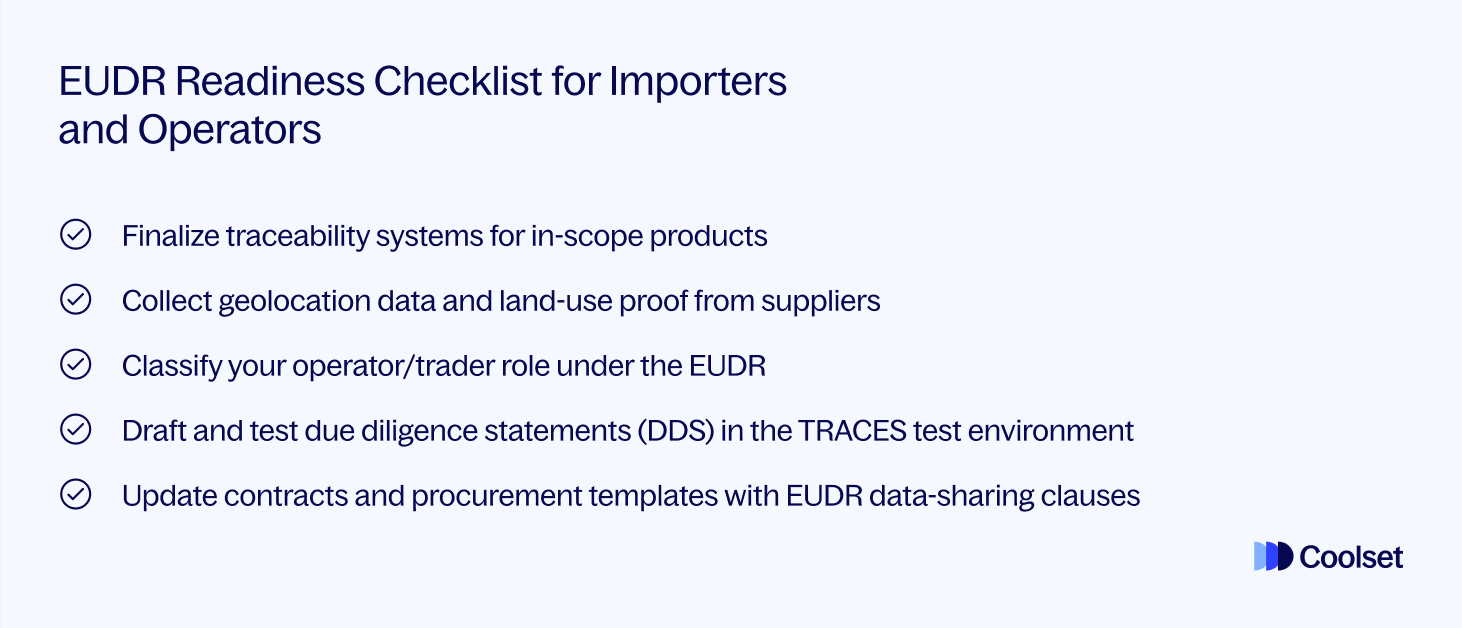
Disclaimer: Latest EUDR developments
On 21 October, the European Commission proposed targeted changes to the EU Deforestation Regulation (EUDR). These adjustments aim to make the rollout smoother without changing the regulation’s overall goals.
Key points from the proposal:
We're closely monitoring the development and will update our content accordingly. In the meantime, read the full explainer here.
On 26 November, a majority in the European Parliament voted in favour of a 12-month delay to the EU Deforestation Regulation (EUDR), and an additional review to propose more simplifications in April 2026. This position is supported by the European People’s Party (EPP) and far-right groups despite failed attempts by other political groups to reach a more moderate compromise.
The vote gives the Parliament an official negotiating position and clears the way for trilogue negotiations, the next step where the Parliament, Council, and Commission work toward agreeing on a final legal text.
No position becomes law until a compromise is reached, adopted, and published in the Official Journal of the EU. Until that final text is adopted and published, the current legal deadline of 30 December 2025 remains in force. However, with all three institutions now aligned in principle, both the delay and simplification review are highly likely to be included in the final outcome.
On 26 November 2025, the European Parliament voted in favour of a package of amendments to the EUDR.
We break them down for you one-by-one:
New timeline put forward by Parliament, now aligned with Council position
New roles and responsibilities defined accepted by Parliament
Additional changes to downstream operator/traders responsibilities
Additional changes to small and micro primary operator responsibilities
A new simplification review
Additional change to operator DDS information needed

Throughout late 2025, EU institutions debated how to adjust the EUDR timeline and reduce administrative complexity, particularly for small and micro primary operators. While the Commission and Council agreed on the need for flexibility, they proposed different approaches.
Here is a more detailed breakdown of each position, including the Parliament’s role.
On October 21 2025, the Commission proposed:
On 17 November 2025, the Council published its official position:
The European Parliament has now voted to support a similar enforcement delay and simplification measures. Both institutions now agree on the core direction of change, allowing trilogue negotiations with the Commission to begin, where the final legal text will be negotiated.
On 26 November 2025, the Parliament:
The legislative process will now move into trilogue discussions, aiming to finalise and adopt the revised EUDR before the end of 2025.
The table below summarises the current positions of the three key EU institutions involved in the EUDR revision process:

The EUDR has evolved from a planned start in 2024, to a delay to 2025, followed by proposals for a grace period and simplified rules for smaller operators. On 26 November 2025, the European Parliament backed a full one-year delay and simplification review. Final details will now be decided in trilogue talks.
Here’s how the timeline has evolved:
Coolset are tracking the latest developments and the official EUDR timeline in this article.
{{custom-cta}}
Not yet. While the Parliament and Council now support the delay, the revised regulation will not become law until a final text is agreed in trilogue and formally adopted.
Trilogues are closed-door meetings where representatives from all three institutions work to agree on a single, final version of the law. This process involves:
Once a provisional agreement is reached, the text is sent back to both the Parliament and Council for formal approval. Only after this second approval is the law adopted and published in the Official Journal of the EU, at which point it becomes legally binding.
A one-year delay is likely, but not confirmed until the final law is adopted. Until that happens, the current legal deadline of 30 December 2025 remains in force.
Companies should continue preparing for EUDR compliance focusing on traceability, supplier data, and due diligence documentation based on their role in the supply chain:
Even amid political uncertainty, companies should move forward with core EUDR readiness activities:
See our checklist below:

Software can reduce friction by connecting data from suppliers, documentation, and internal teams into one process, making it easier to stay aligned with regulatory expectations now and as trialogue discussions develop.
Software platforms such as Coolset help to
Download our EUDR due diligence guide or schedule a free call with our research team to learn more.
Is the EUDR deadline officially delayed?
No. The EUDR deadline of 30 December 2025 remains legally binding. Although the European Parliament and Council now support a one-year delay, the change will only take effect once all three EU institutions agree on a final legal text and it is formally adopted and published in the Official Journal of the EU.
What did the EU Parliament vote for on EUDR?
The European Parliament voted on 26 November 2025 to support a one-year delay to EUDR enforcement, extending the deadline to 30 December 2026 for large operators and 30 June 2027 for small operators. It also backed a simplification review by April 2026, focused on reducing burdens for micro and small primary producers.
Can I pause EUDR preparations until there’s legal clarity?
No. Until a final legal text is adopted, the 2025 deadline remains in force. Delaying preparation risks non-compliance if negotiations stall or the amendment is not adopted in time. Companies should continue building traceability systems, collecting supplier data, and preparing due diligence documentation to stay ahead of potential enforcement.
What does simplification mean for downstream operators?
Under the new amendments, only downstream operators who buy directly from an operator are required to retain and pass on DDS reference numbers. Downstream operators who purchase from other downstream actors are now excluded from EUDR obligations entirely.
What’s happening with the country benchmarking system?
The Parliament previously rejected the Commission’s benchmarking framework. As of today, all countries remain under standard risk, meaning full due diligence is required for all imports.
Get the latest EUDR update and ask your questions live.

Get your systems ready for traceability, risk assessment and due diligence.
